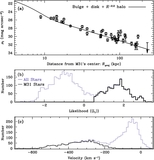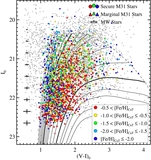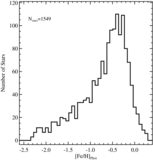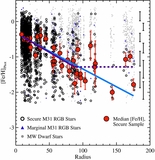Image Details

Caption: Figure 6.
Comparison of the photometric and spectroscopic metallicity estimates. Stars securely identified as M31 red giants are depicted as filled gray circles, while stars with a marginal identification as M31 red giants are depicted by gray triangles. The larger, darker gray points denote stars whose Ca II triplet measurements pass the spectral quality cuts discussed in Section 3.2. The solid line denotes the one-to-one relation. The large black points show the median [Fe/H]phot and [Fe/H]CaT values for all securely identified M31 stars in a series of bins in [Fe/H]phot; error bars denote the error in the median value. The red dashed and blue dot-dashed lines show the running median values when alternate isochrone sets are used to compute [Fe/H]phot. The large, light blue points are the median [Fe/H]phot and [Fe/H]CaT values for stars that pass the quality cuts. Because the S/N per pixel of a typical stellar spectrum is low, individual estimates of [Fe/H]CaT have large error bars, leading to a large spread in [Fe/H]CaT values at a given [Fe/H]phot. However, in aggregate the Ca II triplet based [Fe/H] estimates agree well with [Fe/H] estimates based on the star's position in the color–magnitude diagram.
Copyright and Terms & Conditions
© 2014. The American Astronomical Society. All rights reserved.












